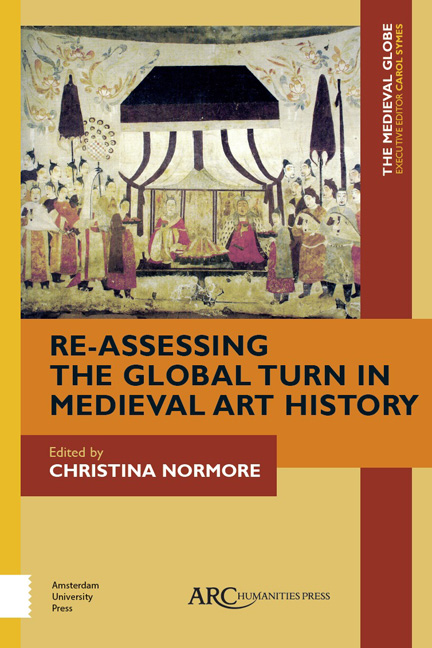Book contents
- Frontmatter
- Contents
- List of Illustrations
- Editor’s Introduction: A World within Worlds? Reassessing the Global Turn in Medieval Art History
- A Camel’s Pace: A Cautionary Global
- The Fatimid Holy City: Rebuilding Jerusalem in the Eleventh Century
- Worldliness in Byzantium and Beyond: Reassessing the Visual Networks of Barlaam and Ioasaph
- Exchange of Sacrifices: West Africa in the Medieval World of Goods
- The Beryozovo Cup: A Byzantine Object at the Crossroads of TwelfthCentury Eurasia
- Mobile Meanings: A Global Approach to a Dagger from Greater Syria
- Global Medieval at the “End of the Silk Road,” circa 756 CE: The Shōsō-in Collection in Japan
- Response: Medievalists and Early Modernists—A World Divided?
- Index
Exchange of Sacrifices: West Africa in the Medieval World of Goods
Published online by Cambridge University Press: 23 January 2021
- Frontmatter
- Contents
- List of Illustrations
- Editor’s Introduction: A World within Worlds? Reassessing the Global Turn in Medieval Art History
- A Camel’s Pace: A Cautionary Global
- The Fatimid Holy City: Rebuilding Jerusalem in the Eleventh Century
- Worldliness in Byzantium and Beyond: Reassessing the Visual Networks of Barlaam and Ioasaph
- Exchange of Sacrifices: West Africa in the Medieval World of Goods
- The Beryozovo Cup: A Byzantine Object at the Crossroads of TwelfthCentury Eurasia
- Mobile Meanings: A Global Approach to a Dagger from Greater Syria
- Global Medieval at the “End of the Silk Road,” circa 756 CE: The Shōsō-in Collection in Japan
- Response: Medievalists and Early Modernists—A World Divided?
- Index
Summary
Oùvergier mainte bone espice, In that orchard, many a spice:
Cloux de girofle et requelice, Studded cloves and liquorice,
Graine de paradis novele, Grain of paradise, newly come,
Citoal, anis, et canele, Zedoary, anise, cinnamon;
Et mainte espice délitable, And many a spice delectable
Que bon mengier fait après table. Good for eating after table.
TOWARDS THE BEGINNING of the Roman de la Rose , Guillaume de Lorris (ca. 1200– ca. 1240) describes the marvellous garden of love, where apple trees grow pomegranates, nut trees sprout nutmegs, and where almond, fig, and date trees flourish within the cloistered walls. These fruits of the orient were joined by every imaginable spice good for cleansing the palate after a meal: cloves, licorice, zedoary, anise, cinnamon, and an exotic new spice, grains of paradise (“Graine de paradis novele”). Written in the third decade of the thirteenth century, Guillaume’s poem marks one of the first instances when this peppery seed (related to the ginger plant) is recorded in western Europe.Also known as melegueta pepper, Aframomum melegueta remained an extremely popular spice at French and Burgundian courts f or appro xima tel y two centuries. Unlike local ly available licorice and anise, or the cinnamon and zedoary (also known as white turmeric) imported from the Indian subcontinent, or the cloves and nutmeg from the spice islands of Indonesia, grains of paradise are native to the rainforests of West Africa and so came to northern Europe by a completely different route.
This longdistance relay network, which linked Guillaume's France to the coastal rainforests of West Africa via transSaharan trade routes, also resulted in the flourishing production of Gothic ivories during this exact same period. From about 1230 to 1500, diptychs, polyptychs, and statuettes ( Plate 5.1 ) made of African elephant ivoryfilled church treasuries and private chapels, while ivory boxes carved with courtly scenes and lavish toiletry sets adorned with flirtatious imagery were de rigueur for aristocratic households. The prevalence of these two materials, elephant tusk and piquant spice, witnesses a profound shift in the trade routes that provisioned European markets with artistic and culinary luxuries, and illustrates the central role that West Africa played in the medieval world system.
- Type
- Chapter
- Information
- Re-Assessing the Global Turn in Medieval Art History , pp. 97 - 124Publisher: Amsterdam University PressPrint publication year: 2018



